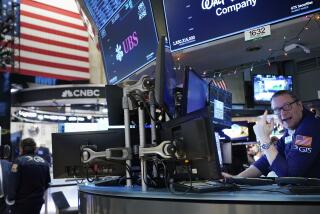Doubts drag down Bank of America’s stock
Bank of America Corp. is facing a crisis of confidence on Wall Street as investors sent the stock tumbling to levels not seen since the financial crisis and the cost of insuring its debt against default rises to near-record levels.
Investors are deeply worried that losses on housing-boom home loans will continue to hurt the beleaguered banking giant, which has taken $76 billion in write-offs over the last two years. Much of the damage stems from its ill-fated takeover of Countrywide Financial Corp., the ultra-aggressive Calabasas mortgage lender.
Unwilling to buy into Chief Executive Brian Moynihan’s assurances that Bank of America is turning the corner on its problems, Wall Street is acting on what the bank and some analysts dismiss as unsound financial projections and fantastical rumors.
After reading a blog report that JPMorgan Chase & Co. would buy Bank of America with help from the U.S. Treasury, “I literally thought, ‘This is something the Onion would print,’” said analyst Paul J. Miller Jr., a mortgage expert who covers BofA for FBR & Co.
Moynihan has repeatedly denied that Bank of America needs to sell stock to strengthen itself with additional capital, which would dilute the holdings of existing shareholders.
In an extraordinary step Tuesday, the bank issued a point-by-point rebuttal to another blog post that accused the bank of needing $100 billion to $200 billion in new capital. BofA called attention to the fact that the blogger, former Merrill Lynch & Co. technology analyst Henry Blodget, had years earlier agreed to be barred from the industry after the Securities and Exchange Commission accused him of conflicts in his research.
But so many observers have suggested that a capital boost may be necessary that there is now an “institutional assumption” that it could come to pass, Miller said.
“Even if you don’t think it’s true, you can’t risk owning the stock at this point, so everybody is selling,” Miller said.
That certainly appeared to be the case Tuesday. As the broad stock market rose 3.4%, lifting most big bank shares higher, Bank of America tumbled more than 6% at one point.
A $50 stock in 2007 and a $10 stock just last month, Bank of America fell 12 cents, or 1.9%, to $6.30 — its lowest level since March 2009. It was the only stock in the Dow Jones industrial average to finish lower on a day in which the blue-chip index rose 322 points.
Credit default swaps on Bank of America’s unsecured debt — a form of insurance against default — were selling for nearly as much as at the height of the financial crisis, analysts said. And short-sellers, often accused of destabilizing the markets by placing bets that stocks will fall, also have targeted the bank in recent days.
The Bank of America battering comes as the financial industry shows signs of having refortified itself after its near-meltdown in 2008 and 2009. Despite an $8.8-billion loss at Bank of America, U.S. banks turned in a collective $28.8-billion profit in this year’s second quarter, up from $20.9 billion a year earlier, regulators reported Tuesday.
What’s more, the number of institutions on the Federal Deposit Insurance Corp.’s “problem list” fell for the first time in nearly five years, dropping to 865 from 888 of the 7,513 banks and savings and loans that were federally insured as of June 30.
However, the FDIC said in a quarterly report that bank revenue fell as low interest rates cut into lending income, loan growth was sluggish and new regulations restricting fees kept service charges on deposit accounts well below pre-financial-crisis levels.
Despite the higher capital levels and returning profits at most banks, investors have found much to worry about these days, and a popular index of bank stocks is down 34% since February.
A major concern is that European banks, particularly in France, are potentially exposed to heavy losses and are less capitalized than U.S. institutions. Investors fear that the failure of a French bank might cause the tightly linked global financial system to seize up, as it did after Wall Street giant Lehman Bros. collapsed in September 2008.
Causing even more concern is the slowdown in the economic recovery, which prompted the Federal Reserve’s unusual recent announcement that it intended to keep a benchmark short-term interest rate at near zero for two more years. Banks won’t make much money if the economy stays weak.
And then there is the general antipathy toward banks, blamed by politicians and the public for causing the Great Recession.
“If there’s one common belief, it’s that banks are no good, banks created all the problems and they need to be punished in any way we can,” said Rochdale Securities analyst Richard X. Bove, who added that there is no rational basis for the stock decline at Bank of America.
Bove said Bank of America’s net worth amounted to $12.40 a share in cash — twice its stock price. He calculated that demands that the bank buy back soured mortgages would result in an additional $35 billion in costs — far from blogger Blodget’s prediction of $100 billion to $200 billion.
RBC Capital Markets analyst Joe Morford noted that the bank was now making money after its big second-quarter loss and that Moynihan, its CEO, had been selling assets that the bank regarded as nonessential, including international credit card holdings and some mortgage servicing rights.
But few investors are paying much attention, Morford said, except when one of the sales falls through, as happened Monday when Bank of America was unable to sell its entire 10% stake in a Chinese bank, driving its stock price lower.
Though Bank of America is in “much stronger shape than a few years ago,” Morford said, the stock “has been detached from the fundamentals.”
“There are a lot of fears and uncertainties out there, especially about that mortgage repurchase risk.”






